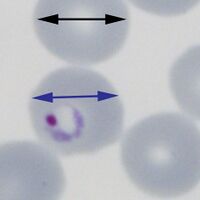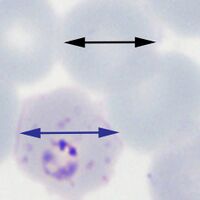|
|
| (One intermediate revision by the same user not shown) |
| Line 6: |
Line 6: |
|
| |
|
| {| class="wikitable" style="border-style: solid; border-width: 4px; color:black" | | {| class="wikitable" style="border-style: solid; border-width: 4px; color:black" |
| |colspan="1" style = "font-size:100%; color:black; background: FFFAFA"|<span style="color:navy>'''How is red cell size and shape affected as malaria develops?'''</span> | | |colspan="1" style = "font-size:100%; color:black; background: FFFAFA"|<span style="color:navy>'''How is red cell size and shape affected in ''P.falciparum''?'''</span> |
|
| |
|
|
| |
|
| During parasite develop,emt each species alters the red cell that they occupy. These changes differ between species causing characteristic changes to.red. cell size and red cell shape. These changes occur from a relatively early stage of parasite development although the very earliest trophozoites may yet show these features
| | Although each species alters the red cell that they occupy, for ''P.faciparum'' the changes are relatively modest for trophozoites (and for the rarely seen schizonts). The changes are much more significant for gametocytes but these are considered separately. ''P.falciparum'' (like ''P.knowlesi'') causes very few changes to red cells for typical ring forms: Red cell size and shape is generally unchanged although they may become crenated |
| | |
| ----
| |
| | |
| '''SMALL ROUND RED CELLS'''
| |
| | |
| ''P.malariae'' | |
| | |
| The red cells in this species remain round and are often small in size
| |
| | |
| <gallery mode="nolines" widths="200px" heights="220px" >
| |
| File:1SizePMET.jpg|A|link={{filepath:1SizePMET.jpg}}
| |
| File:2SizePMLT.jpg|B|link={{filepath:2SizePMLT.jpg}}
| |
| </gallery>
| |
| | |
| The early (A) and late trophozoites (B) shown in this image each lie within round erythrocytes with reduced size.
| |
| | |
| | |
| ----
| |
| | |
| '''RED CELLS WITH UNCHANGED SIZE AND SHAPE'''
| |
| | |
| ''P.falciparum'' (and ''P.knowlesi'') | |
| | |
| Red cell size and shape is generally unchanged although they may become crenated | |
|
| |
|
| <gallery mode="nolines" widths="200px" heights="220px" > | | <gallery mode="nolines" widths="200px" heights="220px" > |
| Line 40: |
Line 16: |
| </gallery> | | </gallery> |
|
| |
|
| The early (A) trophozoites lie within red cells that do not change size or shape, at later development (B) they may remain unchanged or acquire subtle crenation. | | The early (A) trophozoites lie within red cells that do not change size or shape, at later development (B) they may remain unchanged or acquire subtle crenation. |
| | |
| | |
| ----
| |
| | |
| '''ENLARGED AND DISTORTED RED CELLS'''
| |
| | |
| For both ''P.ovale'' and ''P.vivax'' the red cells become progressively enlarged and distorted as the parasites develop. It may not be possible to distingish the species based on red cell appearances, but there are differences which should be looked for.
| |
| | |
| | |
| ''P.ovale''
| |
| | |
| Expect increased red cell size but this may not be marked; the typical shape is an ovoid shape (hence the name) and there may be characteristic finbriation of cytoplams (that may be limited to one pole of the cell).
| |
| | |
| <gallery mode="nolines" widths="200px" heights="220px" >
| |
| File:5SizePOET.jpg|A|link={{filepath:|5SizePOET.jpg}}
| |
| File:6SizePOLT.jpg|B|link={{filepath:4SizePOLT.jpg}}
| |
| </gallery>
| |
| | |
| Early (A) and late (B) trophozoites o ''P.ovale''. In each case there is a tendency for red cells to have an ovoid shape and there is distortion of the cytoplasm with sharp projectiosn (fimbriation). These orregular and spiky projections differ from the rounded crenation that may be seen in ''P.falciparum''.
| |
| | |
| | |
| ''P.vivax''
| |
| | |
| This species tend to have the largest red cell size that becomes evident at quite and early stage; the typical shape is quite irregular fimbriation is not (generally) seen.
| |
| | |
| <gallery mode="nolines" widths="200px" heights="220px" >
| |
| File:7SizePVET.jpg|A|link={{filepath:|7SizePVET.jpg}}
| |
| File:8SizePVLT.jpg|B|link={{filepath:8SizePVLT.jpg}}
| |
| </gallery>
| |
| | |
| Trophozoites of ''P.vivax'' cause increase in size and distortion of red cells as the parasites mature. Here, the the early trophozoite (A) is enlarged but still retains a relatively undistorted elongated shape (similar to ''P.ovale''); however the late form (B) is has a very irregular shape (note that unlike ''P.ovale'' the red cell is not fimbriated).
| |

